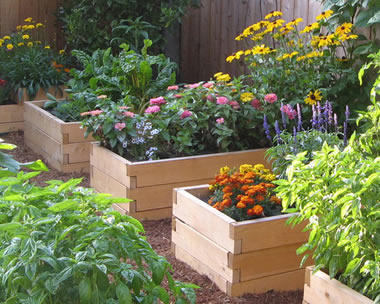Building the garden
If you're a beginner to the raise bed gardening world, laying out the garden in a rectangular pattern is the way to go. Rectangular gardens are easier to maintain and to work on. No matter which design you decide on, make sure to level the area first to make a flat base for starting the project. Other things to keep in mind when you're building a raised bed garden include:
Width and length. If your raised garden bed is accessible from both sides you can make it four feet wide. If the bed is accessible only from one side, limit the width to 3 feet. Most gardeners find it uncomfortable to reach farther than 3 feet to tend the bed. The garden can really be any length suitable to your landscape, but a good workable size is about 12 feet long.

Using a frame
Although most raised bed gardens are framed, they really don't have to be. Some gardeners simply mound up soil, to make planting flowers or vegetables within area landscaping easier. However, using a frame will help keep the soil in place during heavy rains and keep the raised bed garden looking neat. You can use a variety of materials, so long as whatever you choose is sturdy and long lasting. Here are some framing ideas:
- Wood. Avoid using pre-treated lumber for bed frames of vegetable gardens. Chemicals can leach out and injure plants. Use pressure-treated lumber, or rot-resistant cedar or redwood.
- Composite landscape timbers. Some landscape timbers are made to look like weathered wood. They are made from recycled plastic, weather well, are easy to install, and are long lasting.
- Concrete block or stone. A little pricier than wood, but very long lasting, blocks or stones make excellent raised bed garden frames.

Easy access pathways
If you're building more than one raised garden bed, leave walkways in between each bed. When deciding on the width of the walkway, keep in mind that plants at the border of your garden will hang over the edge and that you may want to bring a wheel barrow or garden cart in. For foot traffic only, 1-foot wide paths are usually big enough. Also, put something down on the walkway to keep it from getting muddy. You'll need easy access to those beautiful vegetables and flowers you'll be growing!

No comments:
Post a Comment